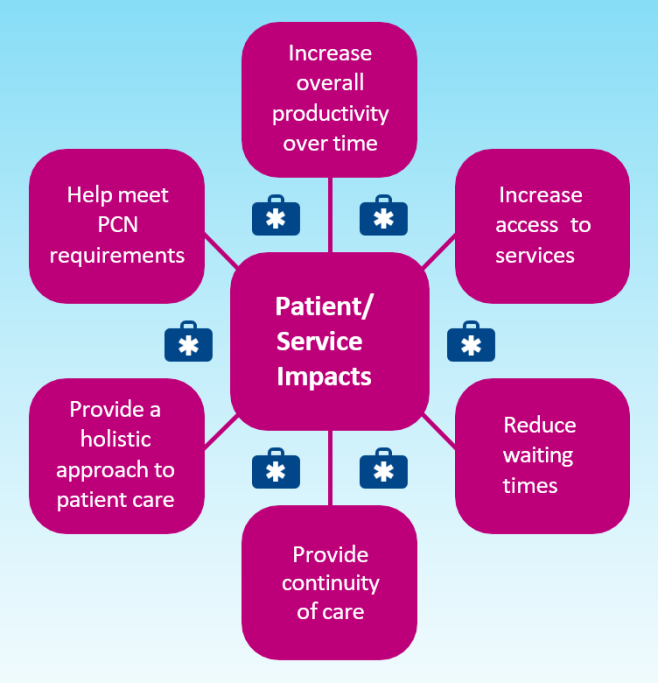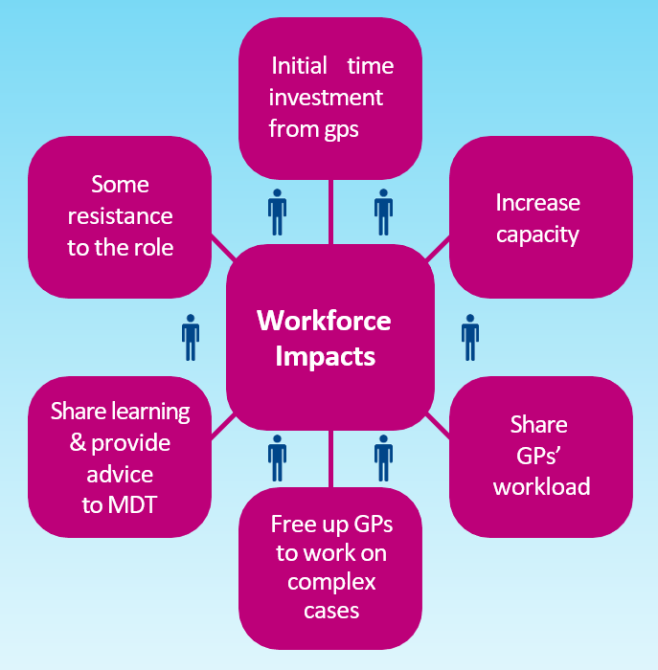You are here
Physician Associate Role (Primary Care) Impact Case Study
Background
Physician Associates (PAs) are healthcare professionals with a generalist medical education who work under the supervision of a doctor to provide medical care. The PA role was first introduced in 2003 and, in 2022, there are approximately 1149 PAs working in General Practice and Primary Care Networks (NHS Digital, August, 2022). This case study provides insight into how the PA roles are typically used in primary care, and the impact of the role on NHS patients, systems, and workforce. The case study data are based on a qualitative analysis of interview data collected from 12 research participants (3 PA leads and 9 PA employers) from 11 NHS primary care organisations across 4 NHS England regions. The data indicate that the perspectives of the leads and the employers are mostly aligned, thus the viewpoints have been combined for the purpose of this case study.
How PA roles are utilised
PAs working in primary care mainly provide routine and acute appointments with some variation between practices in terms of whether these are triaged first. PAs see a lot of patients with chronic conditions (e.g., chronic pain and type 2 diabetes) but typically do not see complex patients or very young children.
Appointment durations with patients tend to be longer than those offered by GPs with length reducing as experience in the role increases.
The scope of practice for the PA role increases over time with many pursuing specialist interests (e.g., minor surgery or contraceptive implant insertion). Many PAs work in urgent treatment centres and walk-in-clinics, whilst others are trained in frailty and have independent weekly care home ward rounds. PAs can work across practices within Primary Care Networks (PCNs) and some do split roles with NHS trusts (e.g., in Emergency Departments).
PAs mainly work core surgery hours. Many practices may soon change this model to enable them to meet the Enhanced Access to General Practice services requirements introduced in October 2022, however some may choose not to given limitations to the PA role. Currently PAs are unable to prescribe and are not permitted to request ionising radiation. Additionally, whilst PAs are trained to interpret blood results, some request and take bloods only, within a locally defined role scope.
At Humberstone Medical Centre, PAs are undertaking regular ward rounds in care homes which is saving GP time whilst providing continuity of care for patients:
“Part of the Direct Enhanced Specifications is to provide a weekly ward round in every care home from a clinician employed by the primary care network. In quite a few we've used the physician associate to do that ward round because she's well placed to do that with her training. And so that saves for instance, a doctor going out to do it every week…”
“I think with the care homes what you're getting with the patient is you're getting continuity, so for instance, the physician associate from my practice goes to the same two care homes every other week and it's always her that goes so there's that continuity of care; she gets to know the patients.”
Dr Aileen Tincello, General Practitioner, Humberstone Medical Centre
 Impacts on patients and service provision
Impacts on patients and service provision
Overall, the data suggest that the PA role positively impacts patients and service provision with impacts increasing as experience in the role increases.
It is apparent that supervising newly qualified PAs can be time-consuming for GPs but after the PAs have gained enough experience, the number of additional patient appointments they can provide outweighs the amount of supervision time required. This means that with time, there is a net gain for practices in terms of productivity.
PAs offer routine and acute on the day appointments. These additional appointments increase access to services and reduce waiting times. Because they have the capacity to follow-up with patients, the data suggest that PAs also provide good continuity of care.
PAs generally have a science background with many having had previous careers in other healthcare backgrounds. The data suggest that this background enables PAs to provide a more holistic approach to healthcare and that they can provide a good wrap-around level of care to patients.
Many PAs are trained in frailty with the data showing that as well as saving GP time, this has several positive impacts on the provision of services for older people and for the patients themselves. For example, PAs undertake regular care home ward rounds which provides good continuity of care for elderly patients. The data also suggest that the older patients particularly value the longer appointments that PAs can offer as it enables them to have an in-depth conversation about their healthcare needs. PAs trained in frailty also develop care plans and undertake proactive healthcare reviews; this helps practices to meet PCN requirements.
“ It's widespread in terms of their [the PA’s] impact. So, I think initially depending on the PA that you get in and their experience, there's an investment from the supervisor in terms of time and energy and upskilling and training. I think that's quite a big investment if I'm being totally honest…but fundamentally you can increase the breadth or the number of appointments that you are supplying for appropriate patients…by that I mean the PA can see patients that are maybe more appropriate for a PA, which should free up time for perhaps a GP who might then see a more complex patient who's frail and has multiple medications and multiple comorbidities, and therefore requires a bit more of an experienced and confident consultant.”
Dr Jonathan Leung, General Practitioner, Greystone House
“ In primary care, where we're doing older adult reviews, they know us because we had a good hour with them. We help build up that rapport and they've been able to express their wishes and discuss things, even little things that might be bothering them.
The feedback from them is that they feel they've been listened to,
and they've had a chance to just say some things that they maybe haven't been able to in the past.”
Sam Hughes, Lead Physician Associate, Care Collaborative PCN
 Impacts on workforce
Impacts on workforce
The data suggest that the PAs help increase workforce capacity within practices and urgent care centres. A key theme is that because PAs can provide appointments to patients with minor ailments, this frees up time for GPs to see patients that only they can see, i.e., those with more complex healthcare issues and who require a more experienced staff member.
Although there is an initial time investment from GPs in terms of supervising newly qualified PAs, once the PAs become more experienced in the role, they can be utilised in several important ways which enable them to share GPs’ workload. For example, PAs can do medical reports (e.g., foster care and DVLA reports) and care home ward rounds which frees up GP time.
The data further suggest that PAs share generalist medical knowledge and learning and provide advice to the wider multidisciplinary team. For example, they provide guidance to nursing staff and support receptionists to provide advice to patients on the phone.
The fact that PAs are unable to prescribe is a significant limitation to the role as it can cause delays for patients and creates work for GPs as they need to check and sign each prescription off. It is also apparent that there is some nervousness around the role from several professions. For example, there is the perception that PAs are taking away postgraduate doctors’ training opportunities, whilst there are hesitations to employing PAs because of the time commitments required in supervising them and a lack of clarity around their capabilities and level of training. The data further suggest that some of this nervousness has been exacerbated by recent media coverage of the role. Overall, whilst perceptions regarding the impact of the role are mixed across professions, this may change in time when the role becomes regulated and if PAs are enabled to become more independent practitioners.
“ It [the PA role] has allowed us to increase our capacity. Obviously, we can see more patients that way. And so, I think it's actually had a positive impact in our urgent treatment centres as well, because it gives us capacity…we've been able to actually fill gaps within our workforce with the PAs.”
Dr Mark Findley, General Practitioner and Medical Director, City Health Partnership CIC
“ It [the PA role] has definitely increased our capacity and because they're doing some of the more task-orientated work, it's able to free up GPs to see the more complex patients.”
Dr Victoria Middleton, General Practitioner, Priory Medical Group, York
Achieving increased impact
To achieve greater impact of the PA role, the data suggest that the following are required:
- GMC regulation
- Ability to prescribe
- Ability to sign fit for work notes
- Ability to request ionising radiation
- Clear pathway for career progression with a postgraduate training option and formal appraisal process
- Increased awareness of the role
- Culture shift to enable more acceptance of the role